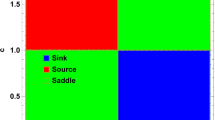Abstract
The apple twig borer (Amphicerus bicaudatus) is an insect pest of the grape vine, causing considerable damage to the grape vine in early spring. A simple difference equation model is formulated and analysed for this plant-herbivore system based on two control strategies, cane removal and pesticide application. The system has two equilibria, one where the pest is present and one where the pest is absent. Regions are found in parameter space for global stability of the equilibria and in the absence of global stability it is shown that there exist periodic or quasiperiodic solutions.
Similar content being viewed by others
Literature
Allen, L. J. S. 1989. A density-dependent Leslie matrix model.Math. Biosci. 95, 179–187.
Allen, L. J. S., M. J. Strauss, H. G. Thorvilson and W. N. Lipe. 1991. A preliminary mathematical model of the apple twig borer (Coleoptera: Bostrichidae) and grapes on the Texas High Plains.Ecol. Modelling 58, 369–382.
Arthur, M. 1991. Development and mathematical analysis of a model for the grape vine and apple twig borer system. MA. Report, Texas Tech University, Lubbock, Texas.
Beddington, J. R., C. A. Free and J. H. Lawton. 1975. Dynamic complexity in predator-prey models framed in difference equations.Nature 255, 58–60.
Beiriger, R. 1988. The bionomics ofAmphicerus bicaudatus (Say), the apple twig borer, on the Texas High Plains. MSc Thesis, Texas Tech University, Lubbock, Texas.
Beiriger, R., H. Thorvilson, W. Lipe and D. Rummel. 1988. The life history of the apple twig borer.Proc. Texas Grape Growers Ass.12, 101–106.
Beiriger, R., H. Thorvilson, W. Lipe and D. Rummel. 1989. Determination of adult apple twig borer sex based on a comparison of internal and external morphology.Southwest. Entomol.14, 199–203.
Beiriger, R., H. Thorvilson, W. Lipe and D. Rummel. 1992. Life history of the apple twig borer in grape on the High Plains of Texas.Am. J. Enol. Viticult., in press.
Edelstein-Keshet, L. 1986. Mathematical theory for plant-herbivore systems.J. math. Biol. 24, 25–58.
Edelstein-Keshet, L. 1988.Mathematical Models in Biology. New York: Random House.
Freedman, H. I. and J. W.-H. So. 1987. Persistence in discrete models of a population which may be subjected to harvesting.Nat. Resour. Modelling 2, 135–145.
Freedman, H. I. and J. W.-H. So. 1989. Persistence in discrete semidynamical systems.SIAM J. math. Anal. 20, 930–938.
Freedman, H. I. and P. Waltman. 1985. Persistence in a model with three competitive populations.Math. Biosci. 73, 89–101.
Gutierrez, A. P., D. W. Williams and H. Kido. 1985. A model of grape growth and development: the mathematical structure and biological considerations.Crop Sci. 25, 721–728.
Hassell, M. P. 1978.The Dynamics of Arthropod Predator-Prey Systems. Princeton: Princeton University Press.
Hsieh, Y.-H. 1988. The phenomenon of unstable oscillation in population models.Math. comput. Modelling 10, 429–435.
May, R. M. 1975. Biological populations obeying difference equations: Stable points, stable cycles, and chaos.J. theor. Biol. 51, 511–524.
May, R. M. 1976. Simple mathematical models with very complicated dynamics.Nature 261, 459–467.
Olsen, L. F. and H. Degn. 1985. Chaos in biological systems.Q. Rev. Biophys. 18, 165–225.
Olsen, L. F., H. Degn, G. L. Truty and W. M. Schaffer. 1988. Oscillations and chaos in epidemics: A nonlinear dynamic study of six childhood diseases in Copenhagen, Denmark.Theor. Pop. Biol. 33, 344–370.
Ortega, J. M. 1987.Matrix Theory A Second Course. New York, London: Plenum Press.
Pakes, A. G. and R. A. Maller. 1990.Mathematical Ecology of Plant Species Competition. Cambridge, New York: Cambridge University Press.
Pielou, E. C. 1977.Mathematical Ecology. New York, London, Sydney, Toronto: John Wiley & Sons.
Rasband, S. N. 1990.Chaotic Dynamics of Nonlinear Systems. New York, Chichester, Brisbane, Toronto, Singapore: John Wiley & Sons.
Schumacher, K. 1983. No-escape regions and oscillations in second order predator-prey recurrences.J. math. Biol. 16, 221–231.
Winkler, A. J. 1962.General Viticulture. Berkely, Los Angeles: University of California Press.
Young, L.-S. 1983. Entropy, Lyapunov exponents, and Hausdorff dimension in differentiable dynamical systems.IEEE Trans. Circuits Syst. CAS-30, 599–607.
Author information
Authors and Affiliations
Rights and permissions
About this article
Cite this article
Allen, L.J.S., Hannigan, M.K. & Strauss, M.J. Mathematical analysis of a model for a plant-herbivore system. Bltn Mathcal Biology 55, 847–864 (1993). https://doi.org/10.1007/BF02460676
Received:
Issue Date:
DOI: https://doi.org/10.1007/BF02460676




